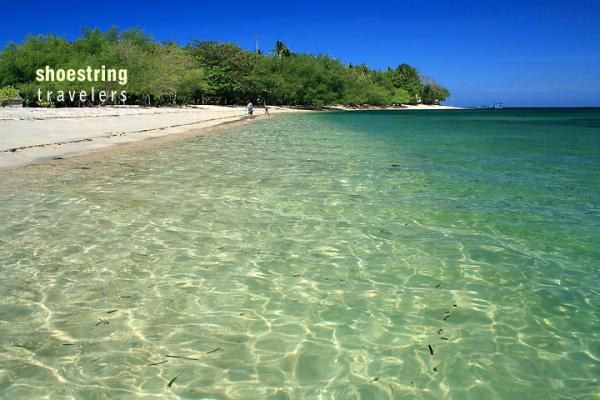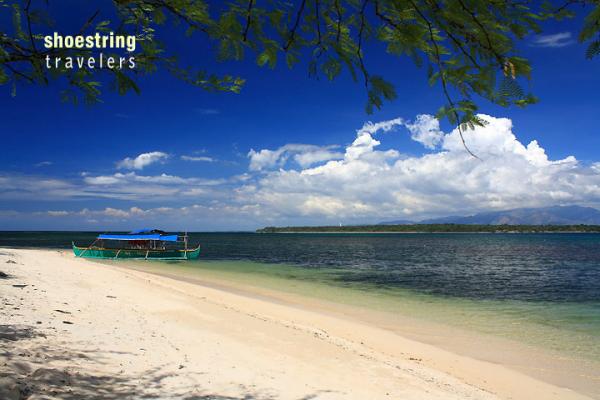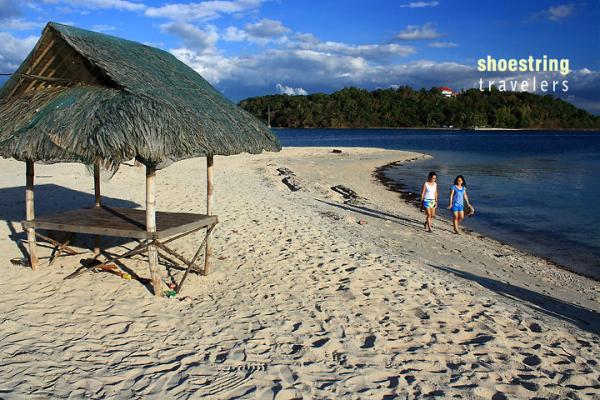
You may also check these:
https://shoestringtravelers.com/?q=node/69
We’ve always made it a point to travel during the first three months of the year. Since these times are considered off-season for tourists, the beaches and islands are usually devoid of the big crowds. There are some cases when we do get a beach or even an island all to ourselves. The downside is that the amihan or northeast monsoon can sometimes wreak havoc with our best-laid travel plans. The northeast monsoon can make inter-island dangerous because of the strong waves that it generates. It was with trepidation therefore that we viewed our trip to Magalawa Island in Palauig, Zambales last February. It had rained hard in Manila two days before our trip and dark patches of clouds were still lingering in the skies when we left for our island getaway. Magalawa’s photogenic beach and emerald-green waters.
Magalawa’s photogenic beach and emerald-green waters.
Fortunately for our friends and us, the skies cleared by the time we were at the North Luzon Expressway and the rest of the trip to the jump-off point for Magalawa at Palauig was uneventful, except perhaps for the last stretch of rough road. The boat ride to Ruiz Resort would last for no more than five minutes, so close is Magalawa to the mainland at this point: our first pleasant surprise. With that short a distance, a strong amihan wave would make no difference. View of distant San Salvador Island from the beachfront of Ruiz Resort, Magalawa Island.
View of distant San Salvador Island from the beachfront of Ruiz Resort, Magalawa Island.
We honestly weren’t expecting much about Magalawa Island and were even planning to just spend one night here before taking our friends to Candelaria and Potipot Island further up north. But one look at the island’s creamy beige sand and emerald green waters and we knew we would be spending all of our 3-day, 2-night getaway here. The cottages at Ruiz Resort are basic, toilets are common, electricity only runs from 6 PM to 6AM and we would be cooking much of our food to limit our costs (in true Shoestring Travelers style) but the Spartan facilities here just added to our overall sense of adventure. It also helped that the people of the resort were very friendly and accommodating. Walking along the beachfront of Armada Resort on the way to the mangrove area.
Walking along the beachfront of Armada Resort on the way to the mangrove area. Rainbow arching over the Palauig mainland at dusk: view from the mangrove area.
Rainbow arching over the Palauig mainland at dusk: view from the mangrove area.
After lunch we realized that we were the only tourists in the resort, and most probably in the whole island, by that time. We simply lazed away the rest of the afternoon swimming at Ruiz Resort’s beachfront or bumming around in some of the open huts. There was plenty of sea grass here that could easily deter swimmers but some 50 meters or so from shore one can already observe plenty of corals. Before evening we sauntered off towards the beachfront at the adjacent Armada Resort (we won’t get into the controversy between the only 2 resorts on the island) for a thoroughly satisfying stroll in the fading light. Our trek brought us to the edge of amangrove area where Leo got some cool shots of a rainbow over theZambales mainland and some sunset views at the water’s edge. Sunset colors on display at the mangrove area on Magalawa’s western shores.
Sunset colors on display at the mangrove area on Magalawa’s western shores.
This island is larger than Potipot but it is still possible to walk around it in 2 hours, according to a boatman we encountered on the way to the mangroves. A little more exploration the following day revealed a fishing village to the north of our resort and another good spot among the mangroves for sunset shots. A fishing village also meant waking up early and getting to choose from the fresh catch the fishermen brought in after a hard night’s work. We spied red snapper (maya-maya), grouper (lapu lapu), fusilier (dalagang bukid), parrotfish, squid and a fish that’s popular here: thetarian. The folks at Ruiz Resort grilled some for us for a minimal fee. Boatmen at a sandbar near San Salvador Island.
Boatmen at a sandbar near San Salvador Island.
Snorkeling with Giant Clams and
the Bacala Resthouse Off San Salvador Island
A pleasant surprise for us was our trip to the waters off nearby San Salvador Island (this island belongs to the municipality of Masinloc). Mang Mulo, the caretaker of Ruiz Resort, offered a ride to the giant clam sanctuary just off San Salvador and a stopover at the Bacala Resthouse along the way. At P200 per person we thought it was a fair enough price and pretty soon we were snorkeling among the corals of the sanctuary. There was nothing too spectacular about the snorkeling but since we had not snorkeled in a while we were soon bubbling up and down amidst the bed of corals like kids.
We could have gone straight back to Magalawa after that but the boatmen said we should have a stopover at the Bacala Resthouse in the middle of the sea just off San Salvador. We had seen this from a distance on our way to the giant clam sanctuary and even though it didn’t seem attractive at that time we decided to give it a go. And fortunately so. The sandbar and the Bacala Resthouse with San Salvador Island in the background.
The sandbar and the Bacala Resthouse with San Salvador Island in the background.
The Bacala Resthouse, it turned out, was right in the middle of a sandbaron this side of San Salvador. The water was crystal-clear, even more so than Magalawa’s. Schools of tiny fishes were swarming all over the sandbar, playfully teasing us. It was the perfect spot for group photo sessions. The rest house in the middle of the sandbar provided shade and accommodations for picnickers and a vantage point for observing nearby San Salvador Island.
We spent our last day at Magalawa Island swimming in front of our resort. Somehow we decided to go back to the beach area in front of the Armada Resort and was pleasantly surprised at how beautiful this beach front is during a sunny day. The waters here are very tempting for a swim although there is a warning sign in a sandy area stretching out towards the mainland forbidding swimmers beyond the point. Apparently a few people have drowned in this area due to strong undercurrents at this portion of the beach. Photogenic beach in front of Armada Resort.
Photogenic beach in front of Armada Resort.
Overall we were very satisfied with our visit here, inconveniences and other issues notwithstanding. Perhaps it was because we had the place practically all to ourselves allowing us to savor its beauty. Magalawa may not be the perfect postcard beauty but it is still a standout in its own right.
Getting There
By car: If you’re taking a private vehicle from Metro Manila drive all the way to Pangolinga in Palauig, Zambales. The fastest way to reach Paluaig is via the North Luzon Expressway (NLEX) and on to the Subic-Clark-Tarlac Expressway (SCTEX). The latter will take you to the Subic Bay Freeport where you can get on back to the national road going to Iba.
After passing through the Iba public market continue to head north until you reach a junction (the Amungan triangle). Keep right to avoid passing through Palauig town and continue on until you reach a second junction (Banlog triangle). Keep right as before, heading north towards Pangolingan. You will pass by a Mt. Tapulao signage, the Zameco Electric Cooperative and a bridge (the Bgy. Salaza Bridge). Look for the welcome sign to Pangolingan. Slow down after this sign and look for a waiting shed on the left side of the road. Turn left on the rough road at this waiting shed (Veritas Road) and drive for around 15-20 minutes until you reach Luan Port and either the Armada Resort parking area or the parking area for Ruiz Resort customers.
By public transpo: Take a bus bound for either Sta. Cruz or Iba, Zambales (Victory Liner has buses going to both places from Metro Manila). If you take the Sta. Cruz bus simply ask the driver to drop you off at the Radio Veritas Road in Bgy. Pangolinan, Palauig, Zambales. If you take the Iba bus you will have to take an ordinary bus at the Iba terminal to connect to Bgy. Pangolinan. The first bus option is obviously better but the buses to Sta. Cruz are not available every hour unlike the Iba buses. From the waiting shed in front of the Veritas Road you can then take tricycles to Luan Port and to either the Ruiz Resort or Armade Resort jump-off points depending on which resort you will be staying.










